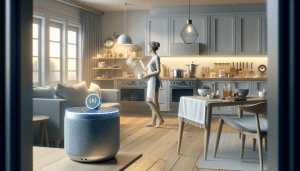You Control Smart Homes With Your Voice and Apps
Aiden Foster September 1, 2025
Discover how smart home technology blends convenience and security, giving you the ability to control lights, thermostats, and appliances from anywhere. This guide explores the essentials of smart homes, popular devices, connectivity, benefits, and privacy considerations. Learn what’s possible for your space as technology and everyday life intertwine.
Understanding Smart Home Technology
Smart home technology transforms ordinary living spaces into connected hubs where comfort and convenience are right at your fingertips. At its core, a smart home integrates devices—like lights, thermostats, plugs, locks, and cameras—using central control systems such as smartphones, tablets, and even voice assistants. This interconnected approach reduces manual tasks. Instead, you manage settings through easy-to-use apps or simple voice commands. Many modern systems use wireless protocols like Wi-Fi, Bluetooth, Zigbee, or Z-Wave, so there’s no need to rewire your home. The main appeal is customization: with a single app or unified hub, you personalize your environment for efficiency, energy savings, and peace of mind.
The concept of home automation goes beyond mere gadgets. It’s about systems working together harmoniously. Imagine your lights dimming at sunset, blinds lowering based on the weather, or your thermostat adjusting before you wake up—all without you lifting a finger. This vision is increasingly attainable due to advancements in the Internet of Things (IoT)—a vast network of connected devices sharing data to automate and optimize home functions. Today’s leading products prioritize user experience, offering intuitive interfaces that allow even non-technologists to take full advantage of these tools. Exploring smart home fundamentals helps identify suitable options and sets the stage for seamless integration in any household.
Convenience is not the only reason people adopt smart home technology. There’s a focus on accessibility and well-being, too. For individuals with mobility limitations, voice-activated controls can make daily routines much simpler and foster greater independence. Energy management also stands out: smart thermostats learn your schedule and adjust heating or cooling for both comfort and efficiency. As manufacturers expand compatibility, more devices become interoperable—even across brands—ensuring flexibility in building your unique system. The accessibility of smart home solutions continues to grow, making this technology relevant and attractive to a diverse range of users (https://www.nist.gov/itl/smart-connected-systems/smart-connected-systems-overview).
Popular Devices for the Modern Smart Home
Smart speakers are often the entry point for new users—devices like Amazon Echo, Google Nest, or Apple HomePod can play music, answer questions, and control other gadgets even as you walk from room to room. These voice assistants offer convenience and hands-free operation using simple voice prompts. Smart plugs and switches help you automate appliances or lighting. Installing them requires no special wiring; just plug in, connect to Wi-Fi, and enjoy automation. Smart thermostats allow you to change your home’s temperature remotely or let them learn your daily patterns for optimal efficiency, helping to reduce energy costs over time.
Home security gets a significant boost from smart devices. Wi-Fi cameras like those from Arlo, Ring, or Wyze stream real-time video to your phone. Smart locks enable keyless entry and flexible guest access, while motion sensors and alarms provide layered security. These systems notify you instantly about activity, making it possible to monitor your property even while away. In addition to security, indoor air quality sensors, smart smoke detectors, and leak detectors add valuable layers of protection and maintenance, empowering users to preemptively address environmental concerns. Each of these innovations makes daily living not only simpler but also safer.
Lighting control is another crowd favorite among smart home enthusiasts. Wi-Fi or Zigbee-powered bulbs—such as those made by Philips Hue or LIFX—put millions of color options and scheduling features in the palm of your hand. Outdoor spaces also benefit as robotic lawn mowers, smart irrigation controllers, and security lighting automate chores and boost curb appeal. For entertainment, smart TVs and streaming devices connect easily with other components, creating immersive media experiences usually controllable with a single remote or app. The universe of compatible devices is constantly expanding, allowing for more inventive and tailored home environments than ever before (https://www.energy.gov/energysaver/articles/tips-smart-home-devices).
Connectivity: Bringing Everything Together
Reliable connectivity is the backbone of an effective smart home. Most modern devices rely on Wi-Fi, though some use other wireless standards—like Zigbee or Z-Wave—which offer enhanced stability and lower power consumption for networks of sensors and gadgets. The quality of your home’s internet can influence performance, especially as you add more devices. Mesh Wi-Fi systems have become a preferred solution for eliminating dead zones and ensuring consistent coverage throughout every room. This robust infrastructure allows seamless device communication, making smart home experiences more responsive and reliable. Integrating devices often involves a central hub, such as Amazon Alexa, Google Home, or Apple HomeKit, which unifies controls and streamlines automations across brands.
Many platforms provide dashboards or apps that organize your devices into logical groups—like ‘living room’ or ‘bedroom’—for easier management. Creating automation routines means your system can trigger actions based on time, location, weather, or occupancy. For example, geofencing can activate lights when you approach home, and sensors can adjust heating when rooms are occupied. Setting up these routines requires little technical skill, thanks to clear interfaces and extensive documentation provided by most manufacturers. Voice control integration further enhances convenience since issuing a spoken command can set off multiple actions at once, like dimming lights and playing your favorite song as soon as you walk in.
Cloud connectivity also enables remote access—manage or monitor your home from work, on vacation, or anywhere with an internet connection. Some devices offer local processing for faster responses and enhanced privacy. Compatibility continues to improve through industry standards like Matter, which aims for interoperability across platforms and brands. This open ecosystem ensures you aren’t locked into a single manufacturer as technologies advance. The bottom line: thoughtful planning and strong connectivity transform smart gadgets into a cohesive, responsive environment tailored to your lifestyle (https://www.cisa.gov/news-events/news/connected-devices-and-smart-home-technology).
Benefits Beyond Convenience
People often expect convenience from smart home technology, but the advantages don’t stop there. Energy management is a powerful benefit—automated thermostats and lighting systems help users track and optimize usage, resulting in lower utility bills. Smart plugs allow homeowners to turn off devices remotely, reducing phantom power draw when devices are not in use. Smart irrigation and leak detectors promote water efficiency and can prevent costly damage by alerting you quickly to problems. These cumulative savings make smart home investments both practical and rewarding over time.
There’s growing interest in how smart technology enhances security and peace of mind. Integrated camera systems give you a live window into your property, while motion sensors and window detectors notify you of unusual activity. Even if you forget to lock the door or arm your alarm on the way out, smart systems allow you to check and update settings via your phone or voice assistant. Automatic lighting can mimic occupancy to deter intruders when you’re away. More innovations like emergency alerts or remote monitoring for elderly family members increase safety and accessibility at home.
Accessibility is another area where smart technology has significant impact. For those with disabilities or limited mobility, voice-controlled and automated systems enable greater independence. Custom routines can support daily tasks: turning lights on at specific times, ensuring pathways are illuminated, or adjusting the thermostat without needing to reach traditional controls. Families can also benefit—parents can monitor nurseries, supervise homework times, or foster routines for children using scheduled events. Collectively, these benefits contribute to not only convenience but also improved well-being, safety, and inclusivity within the household (https://www.ada.gov/resources/assistive-technology/).
Your Privacy and Security in a Connected Home
Networked homes introduce new privacy questions. Each smart device generates data—on behavior patterns, energy use, or occupancy—that may be stored locally or in the cloud. Manufacturers have taken steps to encrypt communications and let users manage access permissions. It is important to review privacy policies and select devices from reputable brands. Regular firmware updates are crucial for blocking vulnerabilities. Multi-factor authentication and strong passwords for apps and hubs are basic precautions every user should employ. Monitoring which devices access your home network builds a safer smart ecosystem.
Third-party integrations present both advantages and risks. Voice assistants often require cloud-based processing, meaning some data leaves your home for external analysis. While these services typically mask user identities, privacy-conscious users can limit data sharing, toggle listening features, or restrict device functionality through settings. Some devices include local-only processing, giving you more control. Understanding and customizing the security settings of each connected device ensures you’re not exposing unnecessary information. Periodic reviews of permissions and connected third parties help maintain tight control over who can access your data and for what purpose.
Cybersecurity experts recommend regular audits of your home network. Dedicated apps and smart hubs allow you to monitor for unusual activity or unauthorized logins. Firewalls and segregated networks for smart devices isolate them from sensitive personal or work files. It’s wise to regularly reset default credentials, keep devices updated, and disable unused features. As smart home devices multiply, manufacturers are prioritizing ongoing security support. Vigilance and proactive management help preserve privacy and trust in your evolving digital household (https://consumer.ftc.gov/articles/connected-homes-and-your-privacy).
Building Your Smart Home—Steps to Get Started
Launching a smart home project doesn’t require major renovations or specialist skills. Start small—perhaps with smart bulbs or a voice assistant—and grow as your needs and budget evolve. Identify your priorities: is energy management, security, accessibility, or entertainment most important? Research which ecosystems—such as Amazon Alexa, Google Home, or Apple HomeKit—offer compatibility with your preferred devices. Comparing options based on features, privacy settings, and price can guide your initial purchases. Most devices offer step-by-step setup guides, and dedicated support forums can answer common installation questions.
Before buying multiple devices, consider the layout of your home and your connectivity needs. Strong Wi-Fi is essential for seamless performance, while certain technologies like Zigbee or Z-Wave may require a dedicated hub. Think about where automation will provide the biggest benefits—automated entryway lights, a programmable thermostat, or smart locks for added peace of mind. Many brands provide starter kits to simplify setup and ensure devices work well together. Embracing a modular approach allows you to expand at your own pace, learning about each technology and its best uses.
Once comfortable with basic controls, try building custom routines. Schedule lights to mimic sunrise, or set reminders for home maintenance. Explore online communities for inspiration; many users share creative automations and troubleshooting advice. It’s also wise to regularly review device settings—update passwords, enable two-factor authentication, and check for new features. Smart home technology brings everyday convenience but also invites users to rethink routines for a dynamic, efficient, and enjoyable living experience (https://www.cnet.com/home/smart-home/how-to-set-up-your-smart-home-for-beginners/).
References
1. National Institute of Standards and Technology. (n.d.). Smart Connected Systems Overview. Retrieved from https://www.nist.gov/itl/smart-connected-systems/smart-connected-systems-overview
2. U.S. Department of Energy. (n.d.). Tips for Smart Home Devices. Retrieved from https://www.energy.gov/energysaver/articles/tips-smart-home-devices
3. Cybersecurity and Infrastructure Security Agency. (n.d.). Connected Devices and Smart Home Technology. Retrieved from https://www.cisa.gov/news-events/news/connected-devices-and-smart-home-technology
4. Ada National Network. (n.d.). Assistive Technology. Retrieved from https://www.ada.gov/resources/assistive-technology/
5. Federal Trade Commission. (n.d.). Connected Homes and Your Privacy. Retrieved from https://consumer.ftc.gov/articles/connected-homes-and-your-privacy
6. CNET. (n.d.). How to Set Up Your Smart Home for Beginners. Retrieved from https://www.cnet.com/home/smart-home/how-to-set-up-your-smart-home-for-beginners/








